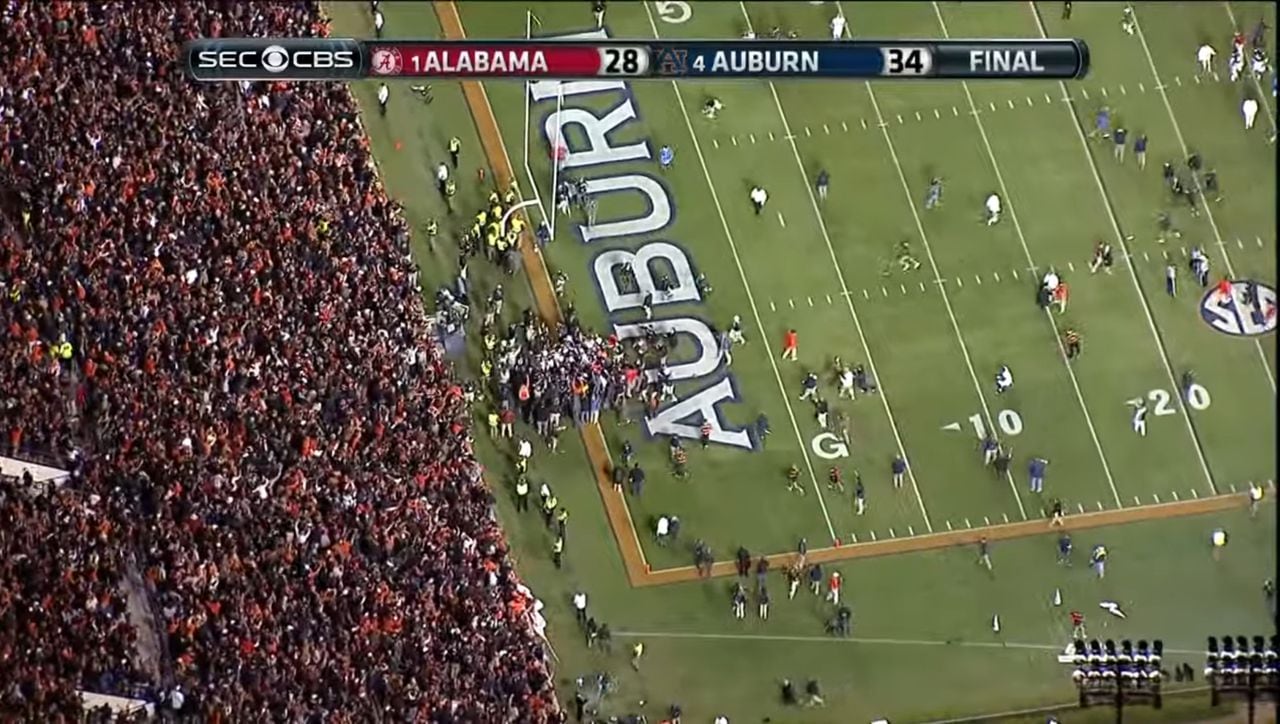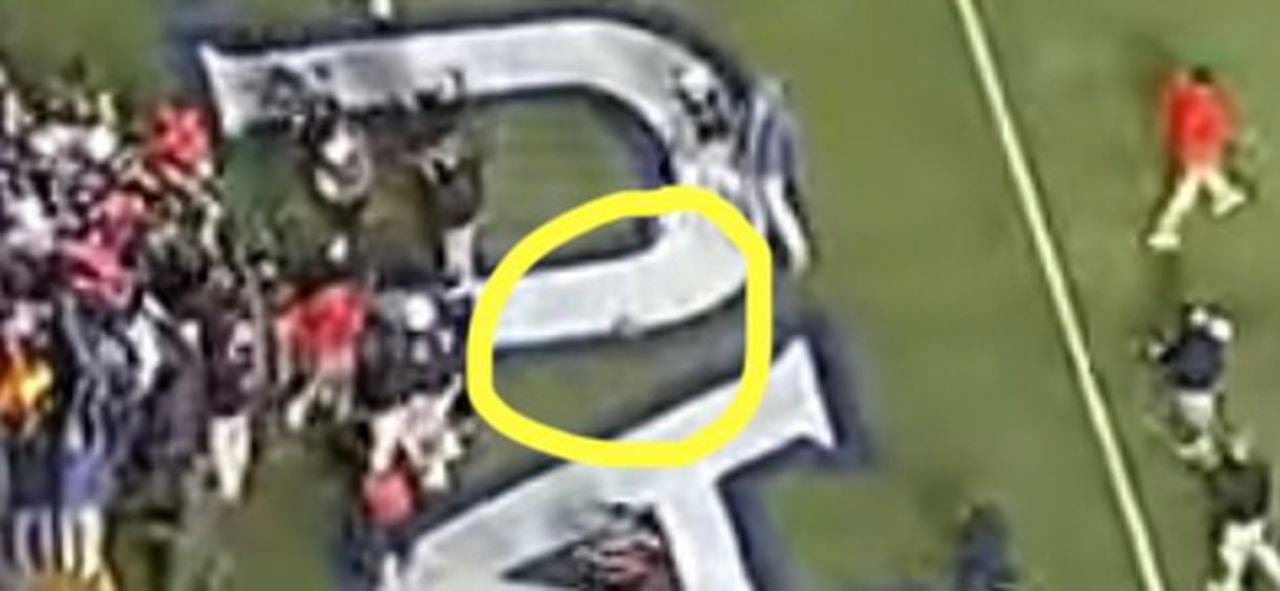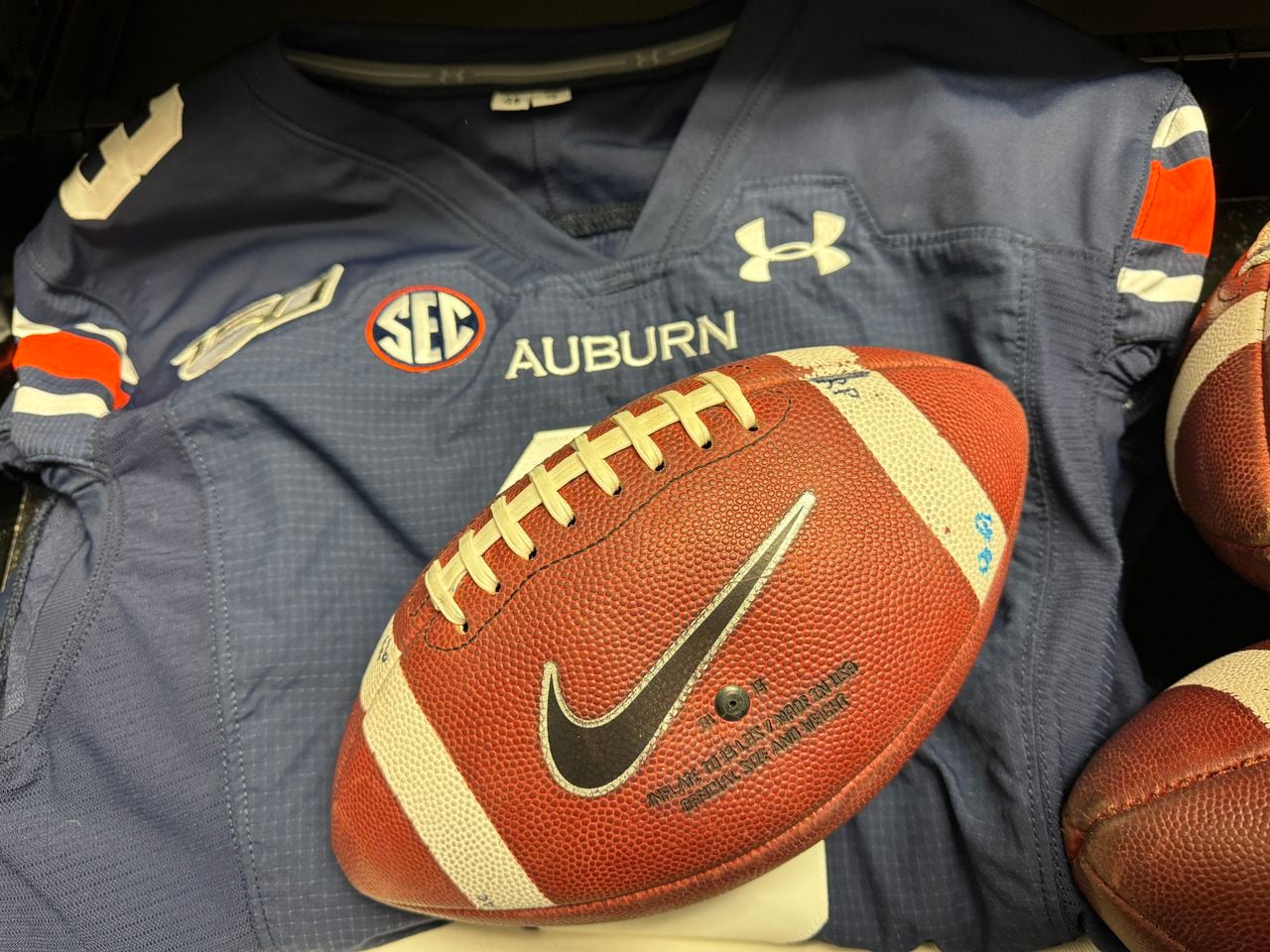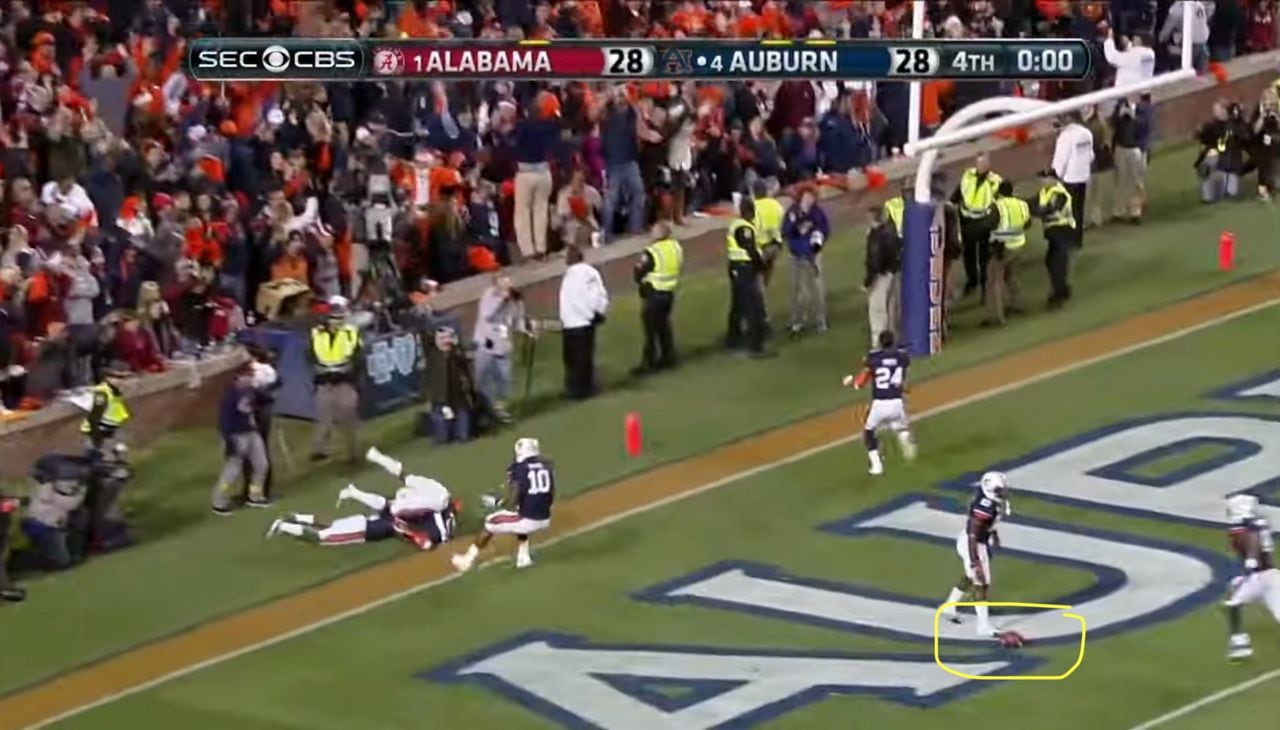Where is the ball from Kick 6? Right now, itâs in an Auburn storage cabinet.
In total, Auburn’s most famous football has only moved about two blocks from the moment where it became history. It started just down the road from the Auburn athletics offices on South Donahue Street at the 39-yard line of Jordan-Hare Stadium.
The ball has been cried over, screamed for and trampled on. It’s been left on the grass, negotiated on phone calls and placed on desks just to peek over and think about what makes it so special.
But 10 years after it made its most famous 109-yard trek, the football that crossed the goal line and scored a game-winning six points for Auburn in the 2013 Iron Bowl is in a box in a storage closet. But anniversaries are a time to remember, and Auburn expects the ball to make one more trip back to Jordan-Hare Stadium.
Its journey began with one second still to play on Nov. 30, 2013, this was still just any other football. It was snapped back and placed down at the 47 and booted toward the goalposts by Alabama kicker Adam Griffith.
The kick came up short, and Auburn cornerback Chris Davis caught the ball. He swung it over into his right hand and ran to his left. Davis cut toward the sideline, skirted away from stepping out of bounds until he had a wide-open field.
“There goes Davis,” the late Auburn radio broadcaster Rod Bramblett called.
Davis was, in fact, gone. He ran the missed field goal back for the most famous touchdown and famous play in Auburn history. And once he strutted across the goal line, just before being at the bottom of a dogpile of teammates while students rushed the field, Davis dropped the ball. It rested right but the blue outline of the first “U” in Auburn.
The Kick 6 football can be seen lying in the endzone during the chaos of the celebration after Auburn’s win on Nov. 30, 2013 at Jordan-Hare Stadium. An Auburn equipment student manager recovered the ball.CBS Sports

The Kick 6 football can be seen lying in the endzone during the chaos of the celebration after Auburn’s win on Nov. 30, 2013 at Jordan-Hare Stadium. An Auburn equipment student manager recovered the ball.CBS Sports

The Kick 6 football can be seen lying in the endzone during the chaos of the celebration after Auburn’s win on Nov. 30, 2013 at Jordan-Hare Stadium. An Auburn equipment student manager recovered the ball.CBS Sports
It’s probably a good thing Davis scored in the north endzone, on the far end of the stadium from the student section. The fans right along the bricks in front of the herd of Auburn players didn’t dart onto the field. Had they, and the ball is likely lost to time and chaos forever.
Dana Marquez, Auburn’s former head of equipment, said he teaches all the students who work for him to pay attention for big moments in a game. That could be a player hitting a career milestone, it could be a record-breaking play. It could be a game-winning touchdown.
Marquez is better known as the ‘Sewing Guy’ from the 2013 Iron Bowl, seen on the sidelines sewing a rip in defensive end LaDarius Owens’ jersey in the fourth quarter. He’s also famously seen with a stoic, arms crossed look on his face standing at the 45-yard-line as Davis raced past him.
He had to be stoic. There is no time for the equipment team to take in that moment. Marquez said he and his team prepare for moments like that. Where he and the other equipment managers have to scramble to take care of every item belonging to the team. None of it is cheap or easily replaceable. Auburn had a game to play the next weekend in Atlanta after all this, anyway.
Somehow, every single Auburn helmet was accounted for during the field storming in 2013 — including stopping one fan who Marquez said had a helmet hidden under his shirt.
Marquez said the student manager who ran toward the ball was fifth-year Andrew Kozup. Well, at least that’s where he was supposed to go. Marquez said Kozup initially ran right past the ball and into the endzone dog pile. But he eventually turned around and saw the ball still lying there.
Kozup grabbed the ball and went home. When Marquez left Jordan-Hare Stadium that night, he had every bit of Auburn’s equipment found and stored. He didn’t know where the ball was. No matter, some fan probably picked it up, he assumed. It was the best piece of memorabilia from the night and it was just lying right there for anyone’s hands to grab.
The next day, Kozup brought the ball back in.
“He’s like, what do I do with it,” Marquez said in a November phone interview with AL.com. “I’m like dude, you should have kept that one.”
Marquez joked had that been him, he probably would have kept the ball and not said anything about it. But the ball had moved to Marquez’s hands, now. His next step was calling Alabama equipment manager Jeff Springer.
History aside, it technically wasn’t Auburn’s ball.
It’s an easily identifiable football. Because Alabama was kicking a field goal, the ball being used was an Alabama football. In pictures of Davis running back the missed kick, the two Nike swooshes can be seen along the side of the ball in his hands. Alabama has an apparel deal with Nike and uses Nike footballs. Auburn wears Under Armour, but primarily used a Wilson football.
With two swooshes on the ball plopped in the endzone this, clearly, was the famous ball. It’s a plain Nike ball, with no script crimson “A” branded on the side.
Springer didn’t want the ball back, Marquez said.
Marquez’s next step was calling then-Auburn Athletic Director Jay Jacobs.
“He said, ‘I got the ball,’” Jacobs remembered Marquez telling him. “I said, ‘You’ve gotta be kidding me.’”
Marquez gave the ball to Jacobs. But he, too, had to call Alabama.
“Hey, I’ve got your football,” Jacobs said he told Alabama’s football administrators at the time. “What do you want me to do with it.”
They laughed.
“Well Jay, quite frankly we don’t have any use for it,” Jacobs said he was told. “So you can have it. That’s your ball.”
It was Auburn’s ball now. Jacobs said he brought it into a staff meeting that week for others in the department to hold it. From there, it went back to his desk. He kept the ball on top of the desk sitting out with no case. Nearby, he had a picture of Ricardo Louis catching the ‘Prayer at Jordan-Hare’ to beat Georgia in 2013.
Jacobs said when people would come into his office for meetings, they’d ask if that was ball from the Kick 6. When Jacobs told them it was, they’d ask for a picture with the ball.
The ball would sit on Jacobs’ desk every day from the weekend of the most famous Iron Bowl to his resignation in 2018.
Jacobs didn’t have a plan for what would happen to the ball when he left. He said he wasn’t going to keep the ball for himself, believing it was Auburn’s football. If he had kept it, Jacobs said it may have ended up in a box eventually. Jacobs said he texted Davis if he wanted the ball, but Jacobs said he didn’t jump at it.
“We know exactly what he did with the ball,” Jacobs said of Davis.
At some point, Jacobs thought the ball might be displayed in Neville Arena. It wasn’t. It was handed down to Auburn’s sports information director for football Kirk Sampson.
Sampson has been in charge of the ball since. Part of his role is serving as an archivist, he said. So in time, the ball was moved into storage. Sampson said it’s in a file cabinet with other pieces of Auburn memorabilia. It’s sat there for years. Sampson hasn’t seen the ball in years, but he knows exactly where it is.
The ball is at an undisclosed location within the Auburn athletics complex. Sampson said there have been plans to properly display the ball. But since Jacobs’ departure, Sampson and the athletics department have faced the COVID-19 pandemic and two coaching changes. Those plans have been pushed down the road. With Auburn’s new Woltosz Football Performance Center now fully constructed and in use, Sampson believes that to be the logical future home.

The football from the Kick 6 sits among other Auburn memorabilia in storage at the Auburn athletics facilityKirk Sampson
But what exactly does a football mean?
It’s an egg-shaped, brown piece of leather. There are dozens around the field at any given time. Now, it’s in storage, like dozens of other assorted pieces of gear, equipment and garb. There, the football is just a football.
But a football, this football, is a symbol. What Davis did with the ball is the most publicly known piece of the story, and the most important. It’s what Davis did with the ball that makes it so unique. It’s where that ball traveled which brought forth screams and tears, panic and chaos, a day one half of this state hopes to shove away and the other will throw their arms up in the air anytime that navy No. 11 jersey streaks across their screen from a November night 10 years ago they’ll never forget.
It’s Auburn’s ball. It’s for the fans. Marquez said the ball is only special if people attribute meaning to it, and this ball undoubtedly means so much to so many.
They can’t relive the exuberance of witnessing that miracle for the first time. But a piece of leather brought back out into the light of day ought to bring back a few memories.
Matt Cohen covers Auburn sports for AL.com. You can follow him on X at @Matt_Cohen_ or email him at [email protected]
